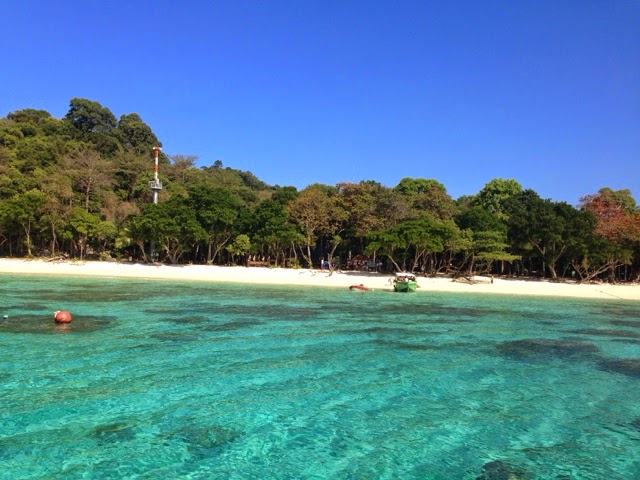Acccording to Burmese lore, the Buddha's teachings of "dhamma" that aimed to liberate practitioners from suffering were diluted in India five centuries after Buddha's death by different religious sects, traditions, and beliefs. However, the pure torch of dhamma was carried on in nearby Myanmar by a few lineages of teachers. (We met an anthropologist in Yangon who is studying Buddhism, and she said that most scholars outside of Myanmar dispute this notion.) Either way, it's a concept that the Burmese are very proud of, and indeed, Buddhism seems to permeate their lives in many ways, from their warm, open smiles and generosity towards strangers to golden pagodas poking up through the landscape, urban or rural, wherever you go.
For example, Thea and I visited the world's largest reclining Buddha a couple days ago, which is in the south of Myanmar:
So taking a meditation course in Myanmar in the tradition of vipassana, the form of meditation taught by Buddha, was truly a gift from the universe. The course itself was identical to vipassana courses worldwide, which were originally started by Burmese vipassana practitioner S.N. Goenka in 1969 in India and gradually spread across six continents. Goenka, who passed away in 2013, filmed and recorded himself so that his teachings are identical across all the centres, although Goenka emphasizes that one's own experiential learning during meditation is the ultimate truth to take away, not what the Buddha or any teacher says.
The courses also all follow the same rigorous timetable:
4 am: wake-up bell (gong, GONG, GONnnnnnnng)
4:30 - 6:30 am: morning meditation (Thankfully Goenka chants for the last half hour, but it's very hard to stay awake.)
6:30 - 8:00 am: breakfast (typically some kind of delicious Burmese noodle soup with veggies and a piece of tropical fruit on the side)
8::00 - 9:00 am: group meditation
9:00 - 11:00 am: meditation in the hall or in the pagoda cell
11:00 am - 12:00 pm: lunch (again, fresh vegetarian Burmese fare, rice with various curried vegetables, fermented tea leaves, soup, and banana for dessert)
12:00 - 1:00 pm: break (nap, do laundry, walk back and forth along the grounds)
1:00 - 2:30 pm: meditation in hall or pagoda cells
2:30 -3:30 pm: group meditation
3:30 - 5:00 pm: meditation in hall or pagoda cells
5:00 - 6:00 pm: tea break (actually Burmese version of Tang and a sugar lump cookie)
6:00 - 7:00 pm: group meditation
7:00 - 8:15 pm: dhamma talk (Goenka's filmed lecture)
8:15 - 9:00 pm: meditation
9:30 pm: lights out!
You read that right: No dinner! And 10 hours of meditation a day. It was one of the most difficult and most rewarding things that I have ever done. The group of 20 foreign women all had various aches and pains from sitting in proper meditation posture with crossed legs and a straight back most of the day, and on the fourth day, we were asked not to change our position during the 1-hour group meditations. It's not masochistic: it helps make the mind more firm and stable in order to observe and accept the sensations that arise and disappear in the body, which is central to re-training your mind to accept impermanence in all areas of life. The 30 Burmese women who were taking the course with us were impressive and stoic sitters, foregoing any extra cushions to prop up aching knees, hips and ankles like us struggling foreigners. And then there's the challenge of being alone with your mind and wandering thoughts for ten days, as we are required to take a vow of Noble Silence for the course!
This was the entryway to the vipassana centre, which transported you into a peaceful, tree- and bird-filled world from the bustling streets of Yangon:
And these were our dormitories, two women to a room (I shared a room with a lovely, tiny Japanese gynecologist):
One of the biggest take-aways of the course for me was the power of my mind over my physical body and pain, as well as over my attitude regardless of what might be occurring externally in life. I learned that simply by observing rather reacting to a painful pins and needles sensation in my leg, the sensation faded away on its own, though the leg remained numb. Soon the sensation did not arise at all during meditation. It felt nearly magical and got me thinking about why meditation couldn't be used more for pain management in a healthcare setting. I could go on and on about the course, but everyone has a unique journey, though we all emerged with bright smiles and the calm presence of a quiet mind. I highly encourage everyone to take the time out of our busy lives to embark on a course: it is 10 days of quality time with yourself, free from distractions, interactions and responsibilities besides the discipline of meditation. All the course info is at www.dhamma.org.
Goenka ended each meditation with a rumbling, sonorous Parli chant of Bhavatu Sabba Mangalam, which means may all beings enjoy true peace, harmony, and happiness. We answered with a chant of Sadu, or "Well Said."
Extending these vibrations your way this morning/evening,
Anna







































